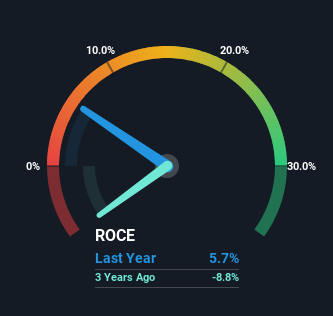The Returns On Capital At tinyBuild (LON:TBLD) Don't Inspire Confidence
Finding a business that has the potential to grow substantially is not easy, but it is possible if we look at a few key financial metrics. In a perfect world, we'd like to see a company investing more capital into its business and ideally the returns earned from that capital are also increasing. Ultimately, this demonstrates that it's a business that is reinvesting profits at increasing rates of return. In light of that, when we looked at tinyBuild (LON:TBLD) and its ROCE trend, we weren't exactly thrilled.
Understanding Return On Capital Employed (ROCE)
For those who don't know, ROCE is a measure of a company's yearly pre-tax profit (its return), relative to the capital employed in the business. Analysts use this formula to calculate it for tinyBuild:
Return on Capital Employed = Earnings Before Interest and Tax (EBIT) ÷ (Total Assets - Current Liabilities)
0.057 = US$6.5m ÷ (US$134m - US$20m) (Based on the trailing twelve months to December 2022).
So, tinyBuild has an ROCE of 5.7%. In absolute terms, that's a low return and it also under-performs the Entertainment industry average of 11%.
See our latest analysis for tinyBuild
Above you can see how the current ROCE for tinyBuild compares to its prior returns on capital, but there's only so much you can tell from the past. If you'd like, you can check out the forecasts from the analysts covering tinyBuild here for free.
The Trend Of ROCE
In terms of tinyBuild's historical ROCE movements, the trend isn't fantastic. Around five years ago the returns on capital were 7.9%, but since then they've fallen to 5.7%. However, given capital employed and revenue have both increased it appears that the business is currently pursuing growth, at the consequence of short term returns. If these investments prove successful, this can bode very well for long term stock performance.
On a related note, tinyBuild has decreased its current liabilities to 15% of total assets. That could partly explain why the ROCE has dropped. Effectively this means their suppliers or short-term creditors are funding less of the business, which reduces some elements of risk. Since the business is basically funding more of its operations with it's own money, you could argue this has made the business less efficient at generating ROCE.
In Conclusion...
While returns have fallen for tinyBuild in recent times, we're encouraged to see that sales are growing and that the business is reinvesting in its operations. But since the stock has dived 88% in the last year, there could be other drivers that are influencing the business' outlook. Regardless, reinvestment can pay off in the long run, so we think astute investors may want to look further into this stock.
Since virtually every company faces some risks, it's worth knowing what they are, and we've spotted 4 warning signs for tinyBuild (of which 3 are potentially serious!) that you should know about.
While tinyBuild isn't earning the highest return, check out this free list of companies that are earning high returns on equity with solid balance sheets.
Have feedback on this article? Concerned about the content? Get in touch with us directly. Alternatively, email editorial-team (at) simplywallst.com.
This article by Simply Wall St is general in nature. We provide commentary based on historical data and analyst forecasts only using an unbiased methodology and our articles are not intended to be financial advice. It does not constitute a recommendation to buy or sell any stock, and does not take account of your objectives, or your financial situation. We aim to bring you long-term focused analysis driven by fundamental data. Note that our analysis may not factor in the latest price-sensitive company announcements or qualitative material. Simply Wall St has no position in any stocks mentioned.

